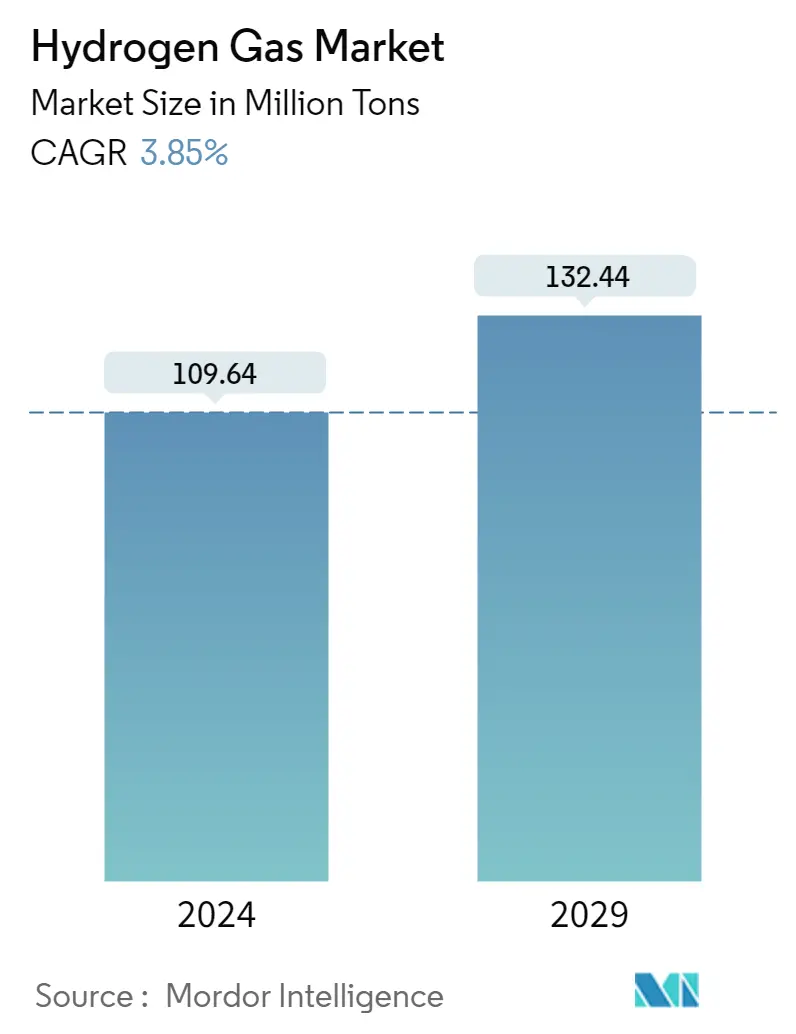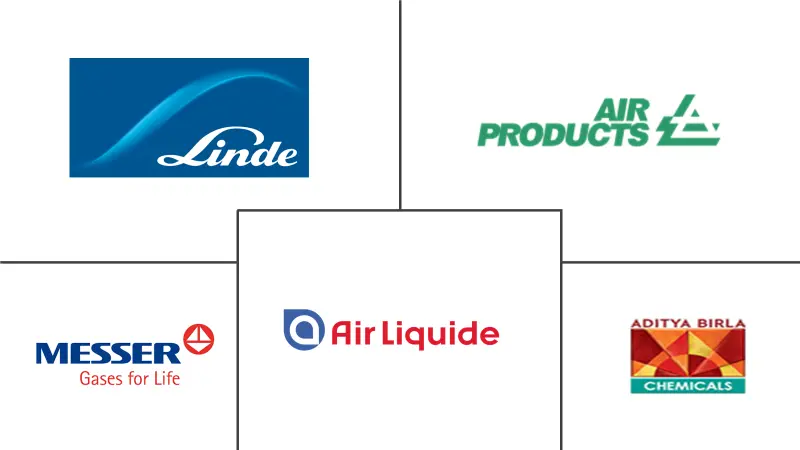Market Size of Hydrogen Gas Industry

| Study Period | 2019 - 2029 |
| Base Year For Estimation | 2023 |
| CAGR (2024 - 2029) | 3.85 % |
| Fastest Growing Market | Asia Pacific |
| Largest Market | North America |
| Market Concentration | High |
Major Players
*Disclaimer: Major Players sorted in no particular order |
Hydrogen Gas Market Analysis
The Hydrogen Gas Market size is estimated at 109.64 Million tons in 2024, and is expected to reach 132.44 Million tons by 2029, growing at a CAGR of 3.85% during the forecast period (2024-2029).
The COVID-19 pandemic negatively impacted the market in 2020. Due to restrictions associated with the pandemic, hydrogen gas production decreased significantly. However, with the relaxation in regulations and improvement in the pandemic situation, it slightly increased in 2021.
- Over the medium term, increasing demand from the chemical Industry and expanding usage of hydrogen in refineries are likely to act as driving factors for the market studied.
- On the flip side, the high production cost of blue and green hydrogen and increased transportation and storage cost is likely to hamper the market's growth.
- Increased space exploration and aviation adoption, increasing demand for fuel cell electric vehicles, and industry readiness of hydrogen in a low carbon economy are likely to act as an opportunity for the market over the forecast period.
- The Asia-Pacific region is dominating the market for hydrogen gas and is expected to remain dominating owing to massive demand from China and India.
Hydrogen Gas Industry Segmentation
Hydrogen gas is a clean, burning, and efficient fuel used in refining processes and producing many chemicals like ammonia and methanol. Hydrogen gas is created through steam methane reforming, coal gasification, and water electrolysis. The hydrogen gas market is segmented by distribution, application, and geography. By distribution, the market is segmented into pipelines, high-pressure tube trailers, and cylinders. By application, the market is segmented into ammonia, methanol, refining, direct reduced iron (DRI), fuel cell vehicles (FCV), and other applications. The report also covers the market size and forecasts for the hydrogen gas market in 15 countries across major regions. For each segment, the market sizing and forecasts have been done based on volume (kilotons).
| Distribution | |
| Pipelines | |
| High-Pressure Tube Trailers | |
| Cylinders |
| Application | |
| Ammonia | |
| Methanol | |
| Refining | |
| Direct Reduced Iron (DRI) | |
| Fuel Cell Vehicles (FCV) | |
| Other Applications |
| Geography | |||||||
| |||||||
| |||||||
| |||||||
| |||||||
|
Hydrogen Gas Market Size Summary
The hydrogen gas market is poised for steady growth over the forecast period, driven by increasing demand from the chemical industry and expanding applications in refineries. Despite the challenges posed by high production costs of blue and green hydrogen, as well as transportation and storage expenses, the market is expected to benefit from opportunities in space exploration, aviation, and the adoption of fuel cell electric vehicles. The Asia-Pacific region, particularly China and India, is a dominant force in the market, fueled by substantial demand and strategic government initiatives aimed at developing a robust hydrogen industry. The region's leadership is further bolstered by significant projects and policies that support the production and use of hydrogen, positioning it as a key player in the global market.
The industrial production of ammonia, a major consumer of hydrogen, continues to drive demand, with the Haber-Bosch process being a primary method for ammonia synthesis. The complexities of hydrogen storage and transportation have led to integrated hydrogen generation units in ammonia and fertilizer production facilities. The market's growth is also supported by major players such as Air Liquide, Linde plc, and Air Products and Chemicals, Inc., who are actively involved in projects and collaborations to enhance hydrogen production and utilization. These developments, alongside strategic investments and partnerships, are expected to significantly impact the hydrogen gas market, ensuring its expansion and integration into a low-carbon economy.
Hydrogen Gas Market Size - Table of Contents
-
1. MARKET DYNAMICS
-
1.1 Drivers
-
1.1.1 Increasing Demand From Chemical Industry
-
1.1.2 Expanding Usage Of Hydrogen In Refinery
-
-
1.2 Restraints
-
1.2.1 High Production Cost Of Blue And Green Hydrogen
-
1.2.2 High Transportation And Storage Cost
-
-
1.3 Industry Value Chain Analysis
-
1.4 Porter's Five Forces Analysis
-
1.4.1 Bargaining Power of Suppliers
-
1.4.2 Bargaining Power of Consumers
-
1.4.3 Threat of New Entrants
-
1.4.4 Threat of Substitute Products and Services
-
1.4.5 Degree of Competition
-
-
-
2. MARKET SEGMENTATION (Market Size in Volume)
-
2.1 Distribution
-
2.1.1 Pipelines
-
2.1.2 High-Pressure Tube Trailers
-
2.1.3 Cylinders
-
-
2.2 Application
-
2.2.1 Ammonia
-
2.2.2 Methanol
-
2.2.3 Refining
-
2.2.4 Direct Reduced Iron (DRI)
-
2.2.5 Fuel Cell Vehicles (FCV)
-
2.2.6 Other Applications
-
-
2.3 Geography
-
2.3.1 Asia-Pacific
-
2.3.1.1 China
-
2.3.1.2 India
-
2.3.1.3 Japan
-
2.3.1.4 South Korea
-
2.3.1.5 Rest of Asia-Pacific
-
-
2.3.2 North America
-
2.3.2.1 United States
-
2.3.2.2 Canada
-
2.3.2.3 Mexico
-
-
2.3.3 Europe
-
2.3.3.1 Germany
-
2.3.3.2 United Kingdom
-
2.3.3.3 Italy
-
2.3.3.4 France
-
2.3.3.5 Rest of Europe
-
-
2.3.4 South America
-
2.3.4.1 Brazil
-
2.3.4.2 Argentina
-
2.3.4.3 Rest of South America
-
-
2.3.5 Middle-East and Africa
-
2.3.5.1 Saudi Arabia
-
2.3.5.2 South Africa
-
2.3.5.3 Rest of Middle-East and Africa
-
-
-
Hydrogen Gas Market Size FAQs
How big is the Hydrogen Gas Market?
The Hydrogen Gas Market size is expected to reach 109.64 million tons in 2024 and grow at a CAGR of 3.85% to reach 132.44 million tons by 2029.
What is the current Hydrogen Gas Market size?
In 2024, the Hydrogen Gas Market size is expected to reach 109.64 million tons.

